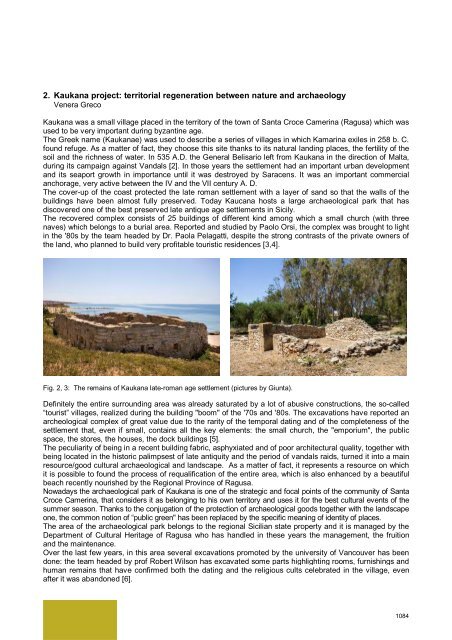Archaeology and nature: hyblean cultural landscape and territorial ...
Archaeology and nature: hyblean cultural landscape and territorial ...
Archaeology and nature: hyblean cultural landscape and territorial ...
You also want an ePaper? Increase the reach of your titles
YUMPU automatically turns print PDFs into web optimized ePapers that Google loves.
2. Kaukana project: <strong>territorial</strong> regeneration between <strong>nature</strong> <strong>and</strong> archaeology<br />
Venera Greco<br />
Kaukana was a small village placed in the territory of the town of Santa Croce Camerina (Ragusa) which was<br />
used to be very important during byzantine age.<br />
The Greek name (Kaukanae) was used to describe a series of villages in which Kamarina exiles in 258 b. C.<br />
found refuge. As a matter of fact, they choose this site thanks to its natural l<strong>and</strong>ing places, the fertility of the<br />
soil <strong>and</strong> the richness of water. In 535 A.D. the General Belisario left from Kaukana in the direction of Malta,<br />
during its campaign against V<strong>and</strong>als [2]. In those years the settlement had an important urban development<br />
<strong>and</strong> its seaport growth in importance until it was destroyed by Saracens. It was an important commercial<br />
anchorage, very active between the IV <strong>and</strong> the VII century A. D.<br />
The cover-up of the coast protected the late roman settlement with a layer of s<strong>and</strong> so that the walls of the<br />
buildings have been almost fully preserved. Today Kaucana hosts a large archaeological park that has<br />
discovered one of the best preserved late antique age settlements in Sicily.<br />
The recovered complex consists of 25 buildings of different kind among which a small church (with three<br />
naves) which belongs to a burial area. Reported <strong>and</strong> studied by Paolo Orsi, the complex was brought to light<br />
in the '80s by the team headed by Dr. Paola Pelagatti, despite the strong contrasts of the private owners of<br />
the l<strong>and</strong>, who planned to build very profitable touristic residences [3,4].<br />
Fig. 2, 3: The remains of Kaukana late-roman age settlement (pictures by Giunta).<br />
Definitely the entire surrounding area was already saturated by a lot of abusive constructions, the so-called<br />
“tourist” villages, realized during the building "boom" of the '70s <strong>and</strong> '80s. The excavations have reported an<br />
archeological complex of great value due to the rarity of the temporal dating <strong>and</strong> of the completeness of the<br />
settlement that, even if small, contains all the key elements: the small church, the "emporium", the public<br />
space, the stores, the houses, the dock buildings [5].<br />
The peculiarity of being in a recent building fabric, asphyxiated <strong>and</strong> of poor architectural quality, together with<br />
being located in the historic palimpsest of late antiquity <strong>and</strong> the period of v<strong>and</strong>als raids, turned it into a main<br />
resource/good <strong>cultural</strong> archaeological <strong>and</strong> l<strong>and</strong>scape. As a matter of fact, it represents a resource on which<br />
it is possible to found the process of requalification of the entire area, which is also enhanced by a beautiful<br />
beach recently nourished by the Regional Province of Ragusa.<br />
Nowadays the archaeological park of Kaukana is one of the strategic <strong>and</strong> focal points of the community of Santa<br />
Croce Camerina, that considers it as belonging to his own territory <strong>and</strong> uses it for the best <strong>cultural</strong> events of the<br />
summer season. Thanks to the conjugation of the protection of archaeological goods together with the l<strong>and</strong>scape<br />
one, the common notion of “public green" has been replaced by the specific meaning of identity of places.<br />
The area of the archaeological park belongs to the regional Sicilian state property <strong>and</strong> it is managed by the<br />
Department of Cultural Heritage of Ragusa who has h<strong>and</strong>led in these years the management, the fruition<br />
<strong>and</strong> the maintenance.<br />
Over the last few years, in this area several excavations promoted by the university of Vancouver has been<br />
done: the team headed by prof Robert Wilson has excavated some parts highlighting rooms, furnishings <strong>and</strong><br />
human remains that have confirmed both the dating <strong>and</strong> the religious cults celebrated in the village, even<br />
after it was ab<strong>and</strong>oned [6].<br />
1084
















